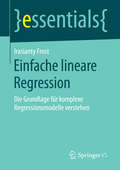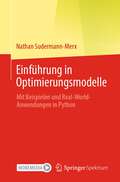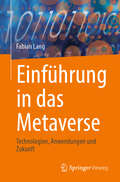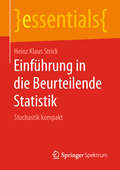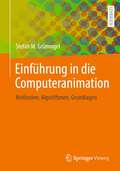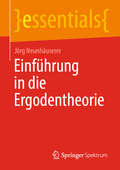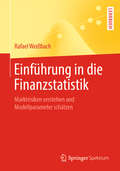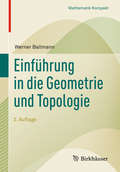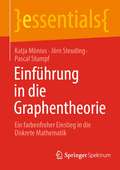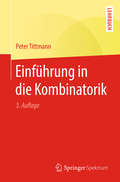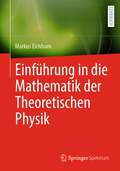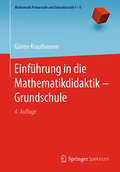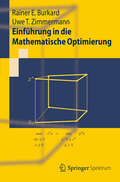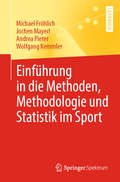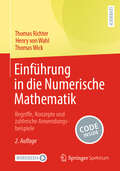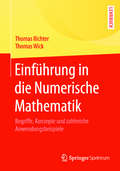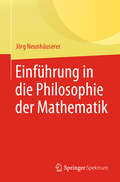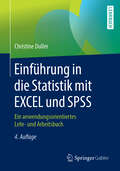- Table View
- List View
Einfache lineare Regression: Die Grundlage für komplexe Regressionsmodelle verstehen (essentials)
by Irasianty FrostDieses essential befasst sich mit der einfachen linearen Regression, der simpelsten Form von Regressionsmodellen, in der f#65533;r die Modellbildung nur eine einzige Einflussvariable ber#65533;cksichtigt wird. Leser finden in diesem Buch die Methode der kleinsten Quadrate zur Sch#65533;tzung der Modellparameter, Residualanalysen zur #65533;berpr#65533;fung der Modellannahmen sowie weitere statistische Verfahren zur Beurteilung des Modells. Zudem erfahren sie, wie das Modell als ein Prognoseinstrument eingesetzt werden kann. Somit erwerben Leser eine solide Grundlage zum Verst#65533;ndnis komplexer Regressionsans#65533;tze, bei denen mehrere Variablen die Zielgr#65533;#65533;e beeinflussen und nichtlineare Zusammenh#65533;nge vorliegen.
Einfluss von Führung auf die Kundenzufriedenheit und die Budgeteinhaltung in vollstationären Pflegeeinrichtungen: Eine empirische Untersuchung
by Stephanie KirschDie vorliegende Erhebung untersucht den Einfluss von Führung auf die Kundenzufriedenheit und die Budgeteinhaltung in stationären Pflegeeinrichtungen. Dabei werden ausgewählte Einflussfaktoren wie z. B. die werteorientierte Kommunikation, die Berücksichtigung von Qualitätsmanagementsystemen sowie die Durchführung von Abweichungsanalysen u. a. in ihrer konkreten Wirkmacht analysiert und eruiert.Die Arbeit leistet einen Beitrag zur Managementforschung und somit für Diskurse über die Versorgungs- und Lebensqualität der Bewohner sowie über die Arbeitszufriedenheit in der vollstationären Pflege und über die Bedeutung von Führung in einem stark regulierten ‚Quasi-Markt‘ der vollstationären Pflege innerhalb des Dienstleistungssektors.Das Senioren-Zuhause der Zukunft erfordert wesentliche architektonische und konzeptionelle Veränderungen sowie eine vielfältige Angebotskultur inkl. einer Quartiersöffnung.Die ermutigende Botschaft besteht in einer Bestätigung der positiven Wirkung des Konzeptes der Interaktionsarbeit mittels einer auf Werten basierenden Kommunikation und Interaktion in sozialen Gefügen.
Einführung in Optimierungsmodelle: Mit Beispielen und Real-World-Anwendungen in Python
by Nathan Sudermann-MerxDieses Buch könnte interessant für Sie sein, falls Sie über eine solide mathematische Ausbildung verfügen und nun Anwendungsprobleme mit Hilfe von Optimierungsmodellen lösen möchten, ohne sich zuvor jahrelang mit der zugehörigen Theorie zu beschäftigen.Ein lineares gemischt-ganzzahliges Optimierungsproblem kann heute etwa 500 Milliarden Mal schneller gelöst werden als zu Beginn der 90er Jahre und lässt sich in leicht zu erlernenden Programmiersprachen wie Python formulieren. Da Sie Optimierungsalgorithmen für Real-World-Anwendungen in der Regel nicht selbst schreiben werden, lassen wir diesen Aspekt außen vor und wenden uns stattdessen der wunderschönen Welt der Modellierung zu. Sie lernen, echte Anwendungen in der Sprache der Mathematik zu beschreiben und implementieren alle vorgestellten Modelle in Python, um sie anschließend von bereits existierenden Solvern lösen lassen. Dieses anwendungsnahe Vorgehen soll Sie befähigen, selbst Optimierungsprobleme in der Praxis zu lösen.
Einführung in das Metaverse: Technologien, Anwendungen und Zukunft
by Fabian LangDieses Buch bietet eine fundierte Einführung in die Grundlagen, Prinzipien und Anwendungen des Metaverse. Es beleuchtet die wesentlichen Aspekte erweiterter Realitäten und virtueller Welten und legt besonderen Wert auf die Verknüpfung mit dem dezentralen Web3 und Distributed-Ledger-Technologien. Diese Verbindung schafft neue Möglichkeiten für zukunftsweisende Geschäftsmodelle im Metaverse. Neben den theoretischen Grundlagen präsentiert das Buch praxisnahe Fallstudien, die reale Anwendungsbeispiele aus verschiedenen Branchen beleuchten und wertvolle Einblicke für Strateg:innen und Innovator:innen bieten. Es widmet sich auch den technologischen, rechtlichen und sozialen Herausforderungen und liefert einen interdisziplinären Ausblick auf die Zukunft und Entwicklung des Metaverse – jenseits des Hypes. Mit umfassenden Erklärungen, praxisorientierten Einordnungen und über 100 anschaulichen Abbildungen richtet sich dieses Buch an Innovations- und Digitalmanager:innen, Studierende sowie alle, die verstehen möchten, wie das Metaverse die Wirtschaft und Gesellschaft transformieren könnte.
Einführung in das Thema Schlüsselkompetenzen (essentials)
by Eckehard MüllerSchlüsselkompetenzen spielen immer mehr eine entscheidende Rolle. In diesem essential werden ausgehend von dem allgemeinen Kompetenzbegriff Schlüsselkompetenzen definiert. Es wird die Einteilung der Schlüsselkompetenzen aufgezeigt. Der Kanon der Schlüsselkompetenzen, definiert durch EU und OECD, wird dargelegt. Die Bestimmung der persönlichen Ausprägung und die Prüfungsmethode von Schlüsselkompetenzen werden aufgezeigt. Ein Ausblick auf künftige Erweiterungen des Spektrums der Schlüsselkompetenzen wird diskutiert.
Einführung in den Lagrange- und Hamilton-Formalismus: Kanonische Theorie klassischer Teilchen und Felder
by Robin SantraDieses Lehrbuch bietet eine elementare Einführung in die Formulierung von physikalischen Modellen mithilfe des Lagrange-Formalismus und des Hamilton-Formalismus. Es schafft die Grundlagen für das Studium der Quantenmechanik und der Quantenfeldtheorie und damit für die Physik der Elementarteilchen und der Vielteilchensysteme. Im ersten Teil dieses Lehrbuchs werden Konzepte der Variationsrechnung vermittelt und der kanonische Formalismus anhand der Mechanik klassischer Teilchen entwickelt. Darauf aufbauend wird im zweiten Teil der Übergang zu unendlich vielen physikalischen Freiheitsgraden vorgenommen und die Verwendung des kanonischen Formalismus für klassische Feldtheorien erklärt. Als Beispiel werden die Maxwell-Gleichungen der klassischen Elektrodynamik in die elegante Sprache des kanonischen Formalismus transformiert. Im abschließenden dritten Teil wird eine Einführung in den Tensorbegriff geboten und demonstriert, wie sich mithilfe von Tensoren die Prinzipien der Speziellen Relativitätstheorie systematisch mit dem kanonischen Formalismus verbinden lassen. Dieses Lehrbuch eignet sich als studienbegleitende Lektüre im Bachelorstudiengang Physik für Vorlesungen der Theoretischen Physik, insbesondere nach dem ersten Studienjahr.
Einführung in die Beurteilende Statistik: Stochastik kompakt (essentials)
by Heinz Klaus StrickIn diesem zweiten Teil von Stochastik kompakt erläutert Heinz Klaus Strick Grundbegriffe und Methoden der Beurteilenden Statistik. Mithilfe der Sigma-Regeln für Binomialverteilungen können Prognosen für Zufallsversuche vorgenommen werden, wobei zwischen verträglichen und signifikant abweichenden Stichprobenergebnissen unterschieden wird. Hieraus wird die Vorgehensweise beim Testen von Hypothesen entwickelt, einschließlich der damit verbundenen Fehlerbetrachtungen. Am Ende wird der Binomialtest zum Chiquadrat-Anpassungstest erweitert. Der Autor Heinz Klaus Strick war 37 Jahre lang als Lehrer für Mathematik und Physik an einem Gymnasium in Leverkusen tätig. Durch seine fachdidaktischen Aufsätze, Schulbücher, Vorträge und Lehraufträge an verschiedenen Universitäten wurde er bekannt. Für seine Aktivitäten und insbesondere für seine Anregungen zum Stochastikunterricht wurde ihm 2002 der Archimedes-Preis der MNU verliehen.
Einführung in die Bioinformatik in der Mikrobiologie
by Henrik ChristensenDieses Lehrbuch führt in die grundlegenden Konzepte der Bioinformatik ein und verbessert die Fähigkeiten der Studierenden im Umgang mit Software und Werkzeugen, die speziell für die Lösung von mikrobiologischen Fragestellungen relevant sind. Es werden die wichtigsten Methoden zur Analyse von Daten aufgezeigt und die Leser werden darin geschult, auf der Grundlage der erzielten Ergebnisse gültige Schlussfolgerungen zu ziehen. Weiters stellen die Autoren hilfreiche Programme und Server vor, die kostenlos im Internet genutzt werden können, präsentieren aber zusätzlich fortgeschrittenere eigenständige Software als zweite Option.. Zur Vertiefung des Erlernten werden am Ende jedes Kapitels unterhaltsame Übungen und Quizfragen angeboten. Das Buch richtet sich an Doktoranden und fortgeschrittene Studierende der Mikrobiologie, Biotechnologie und (Veterinär-)Medizin mit geringen bis grundlegenden Kenntnissen in Bioinformatik.
Einführung in die Computeranimation: Methoden, Algorithmen, Grundlagen
by Stefan M. GrünvogelDas Buch ist das erste umfassende deutschsprachige Lehrbuch zur Computeranimation, das sich speziell an Studierende der Informatik und der Ingenieurwissenschaften richtet, die ihr Verständnis der mathematischen Grundlagen und Algorithmen dieses spannenden Gebiets vertiefen wollen. Das Lehrbuch ist in vier Hauptteile gegliedert und deckt damit alle wichtigen Bereiche der Computeranimation ab: Animationssysteme, Objektanimation, Charakteranimation und Prozedurale Animation. Jeder Teil ist in weitere Kapitel unterteilt und bietet eine detaillierte Darstellung der Algorithmen und Methoden der Computeranimation mit ausführlichen Erklärungen.Im ersten Teil werden die wichtigsten Konzepte von Animationssystemen wie Szenengraphen, Zeit und Game Loop erläutert. Im zweiten Teil geht es um die Animation und Steuerung von Objekten entlang von Kurven, die die Grundlage vieler Animationstechniken bilden. Im dritten Teil wird das Gebiet der Charakteranimation ausführlich behandelt. Kinematik und inverse Kinematik werden diskutiert, Skinning-Methoden vorgestellt und Motion-Capture und die Verarbeitung von Bewegungsdaten ausführlich beschrieben. Der letzte Teil des Buches beschäftigt sich mit der prozeduralen Animation und stellt verschiedene Algorithmen für physikalisch basierte Animation und Partikelsysteme vor. Im gesamten Buch finden sich zahlreiche Beispiele und Illustrationen, die das Verständnis der behandelten Konzepte und Verfahren vertiefen. Am Ende jedes Kapitels finden sich Verweise auf historische und weiterführende Literatur, die zu weiterer Forschung anregen. Ein wichtiger Teil des Buches sind die zahlreichen Übungen und Projekte, die helfen, das Gelernte zu vertiefen und selbst zu erproben.
Einführung in die Ergodentheorie (essentials)
by Jörg NeunhäusererDieses essential gibt eine kompakte Einführung in die Ergodentheorie, die Dynamische Systeme mit Methoden der Maßtheorie untersucht. Lesende lernen wundervolle Resultate von herausragenden Mathematikern des 20. Jahrhunderts kennen. Eine Fülle von Beispielen Dynamischer Systeme mit invarianten und ergodischen Maßen werden beschrieben. Zusätzlich finden sich großartige Anwendungen der Ergodentheorie in der Zahlentheorie.
Einführung in die Finanzstatistik: Marktrisiken verstehen und Modellparameter schätzen
by Rafael WeißbachDieses Buch verzahnt die wesentlichen Grundlagen aus Mathematik, Wirtschaft und Statistik, die zum Verständnis von Finanzmärkten nötig sind. Es ist für (angehende) Praktiker und Theoretiker gleichermaßen geeignet.Die Vielschichtigkeit, Schnelllebigkeit und Komplexität des Themengebiets schließt eine umfassende und zugleich übersichtliche Gesamtdarstellung geradezu aus – die in diesem Buch dargestellten Inhalte bilden jedoch eine solide Basis, mit der sich der Leser weiterführende Literatur zügig selbst erschließen kann:Mit welchen Risiken sind die Akteure auf dem Finanzmarkt konfrontiert – und wie quantifizieren sie diese?Wodurch sind Finanzprodukte (etwa Kredite, Termingeschäfte, Aktienoptionen) mathematisch charakterisiert?Welche Gedankengänge stehen hinter der Lenkung von Großbanken?Welche Rolle spielen Ratings?Wie können Risikomodelle statistisch kalibriert werden?Wie können Daten vergangener Zahlungsströme genutzt werden, um Parameter für Zukunftsmodelle zu schätzen?Die jeweils verwendete Darstellungsform entspricht der Vielschichtigkeit des Anspruchs: Zahlenbeispiele stehen neben bewiesenen Sätzen, Abbildungen und Tabellen unterstützen die Erklärungen. Die typischerweise englischen Fachbegriffe werden ergänzend aufgeführt, so dass der Leser sich in der gängigen Notation gut zurechtfinden kann.
Einführung in die Funktionalanalysis (Mathematik Kompakt)
by Christian ClasonFunktionalanalysis hat sich in den letzten Jahrzehnten zu einer der wesentlichen Grundlagen der modernen angewandten Mathematik entwickelt, von der Theorie und Numerik von Differentialgleichungen über Optimierung und Wahrscheinlichkeitstheorie bis zu medizinischer Bildgebung und mathematischer Bildverarbeitung.Das vorliegende Lehrbuch bietet eine kompakte Einführung in die Theorie und ist begleitend für eine vierstündige Vorlesung im Bachelorstudium konzipiert. Es spannt den Bogen von den topologischen Grundlagen aus der Analysis-Grundvorlesung bis zur Spektraltheorie in Hilberträumen; besondere Aufmerksamkeit wird dabei den zentralen Resultaten über Dualräume und schwache Konvergenz geschenkt.
Einführung in die Funktionalanalysis (Mathematik Kompakt)
by Christian ClasonDas vorliegende Lehrbuch bietet eine kompakte Einführung in die Theorie der Funktionalanalysis und ist begleitend für eine vierstündige Vorlesung im Bachelorstudium konzipiert. Es spannt den Bogen von den topologischen Grundlagen aus der Analysis-Grundvorlesung bis zur Spektraltheorie in Hilberträumen; besondere Aufmerksamkeit wird dabei den zentralen Resultaten über Dualräume und schwache Konvergenz geschenkt. In dieser zweiten Auflage wurden Fehler korrigiert und die Darstellung an einigen Stellen verbessert. Zusätzlich wurden die Aufgaben insbesondere um eine Sammlung von Lernzielfragen als Hilfestellung für das Selbststudium oder für die Prüfungsvorbereitung ergänzt.
Einführung in die Geometrie und Topologie (Mathematik Kompakt)
by Werner BallmannDas Buch bietet eine Einführung in die Topologie, Differentialtopologie und Differentialgeometrie. Nach einer Einführung in grundlegende Begriffe und Resultate aus der mengentheoretischen Topologie wird der Jordansche Kurvensatz für Polygonzüge bewiesen und damit eine erste Idee davon vermittelt, welcher Art tiefere topologische Probleme sind. Im zweiten Kapitel werden Mannigfaltigkeiten und Liesche Gruppen eingeführt und an einer Reihe von Beispielen veranschaulicht. Diskutiert werden auch Tangential- und Vektorraumbündel, Differentiale, Vektorfelder und Liesche Klammern von Vektorfeldern. Weiter vertieft wird diese Diskussion im dritten Kapitel, in dem die de Rhamsche Kohomologie und das orientierte Integral eingeführt und der Brouwersche Fixpunktsatz, der Jordan-Brouwersche Zerlegungssatz und die Integralformel von Stokes bewiesen werden. Das abschließende vierte Kapitel ist den Grundlagen der Differentialgeometrie gewidmet. Entlang der Entwicklungslinien, die die Geometrie der Kurven und Untermannigfaltigkeiten in Euklidischen Räumen durchlaufen hat, werden Zusammenhänge und Krümmung, die zentralen Konzepte der Differentialgeometrie, diskutiert. Den Höhepunkt bilden die Gaussgleichungen, die Version des theorema egregium von Gauss für Untermannigfaltigkeiten beliebiger Dimension und Kodimension.In der zweiten Auflage habe ich eine Reihe von Textstellen leicht überarbeitet und einige Fehler berichtigt.
Einführung in die Graphentheorie: Ein farbenfroher Einstieg in die Diskrete Mathematik (essentials)
by Jörn Steuding Katja Mönius Pascal StumpfDieses essential liefert eine Einführung in die Graphentheorie; Vorkenntnisse werden dabei nicht benötigt. Ein Graph ist ein Gebilde bestehend aus Ecken und verbindenden Kanten. Wir untersuchen Kreise in Graphen (die jede Kante bzw. jede Ecke besuchen sollen), fragen uns, welche Graphen sich überschneidungsfrei zeichnen lassen, und schließlich machen wir uns an die Färbung von Graphen (wobei keine benachbarten Ecken mit derselben Farbe versehen werden sollen). Diese klassischen Themen der Graphentheorie werden durch eine Vielzahl von Illustrationen und einigen historischen Anmerkungen untermalt; motivierende Übungsaufgaben (mit Lösungen) und viele bunte Beispiele erleichtern den Einstieg in dieses aktuelle und vielseitige Gebiet der Mathematik.
Einführung in die Kombinatorik
by Peter TittmannDieses Lehrbuch vermittelt die Grundlagen und Konzepte der modernen Kombinatorik in anschaulicher Weise. Die verständliche Darlegung richtet sich an Studierende der Mathematik, der Naturwissenschaften, der Informatik und der Wirtschaftswissenschaften und erlaubt einen einfachen und beispielorientierten Zugang zu den Methoden der Kombinatorik. Beginnend mit den Grundaufgaben der Kombinatorik wird der Leser Schritt für Schritt mit weiterführenden Themen wie erzeugende Funktionen, Rekurrenzgleichungen und der Möbiusinversion sowie Graphenpolynomen und endlichen Automaten vertraut gemacht. Eine Vielzahl von Beispielen und Übungsaufgaben mit Lösungen erleichtern das Verständnis und dienen der Vertiefung und praktischen Anwendung des Lehrstoffes. Die vorliegende dritte Auflage ist komplett durchgesehen und deutlich erweitert um das Thema Kombinatorische Klassen und weitere, auch für die praktische Anwendung wichtige Graphenpolynome.
Einführung in die Mathematik der Theoretischen Physik
by Markus EichhornDieses Lehrbuch stellt die mathematischen Methoden der Theoretischen Physik detailliert und anschaulich dar. Das Hauptaugenmerk liegt dabei auf der verständlichen Herleitung und der Anwendbarkeit auf physikalische Probleme. Mathematische Herleitungen und Rechenkniffe werden Studierenden dabei in vielen Zwischenschritten zugänglich gemacht. Das Lehrbuch richtet sich primär an Studierende der ersten Semester, ist aber durch das gesamte Grundstudium hindurch und darüber hinaus als Referenz- und Nachschlagewerk geeignet. Darüber hinaus sind viele Beispiele für fortgeschrittene Studierende, wie der Formalismus der Allgemeinen Relativitätstheorie oder Lie-Algebren eingearbeitet. Am Ende jedes Kapitels befinden sich Formelsammlungen, die die Themen zusammenfassen und so einen kompakten Überblick über die einzelnen Zusammenhänge liefern.
Einführung in die Mathematikdidaktik – Grundschule
by Günter KrauthausenIn dieser Einführung in die Didaktik des Mathematikunterrichts der Primarstufe werden zunächst inhaltliche Grundlagen der drei Bereiche Arithmetik, Geometrie und Sachrechnen angesprochen. Zentrale Grundideen des Mathematiklernens wie etwa ein zeitgemäßes Verständnis von Lehren, Lernen und Üben, didaktische Prinzipien und allgemeine Ziele des Mathematikunterrichts werden dargestellt. Die Diskussion ausgewählter Aspekte der Organisation von Lernprozessen sowie klassischer Spannungsfelder des Mathematikunterrichts schließt sich an. Diese Aussagen sind in weiten Teilen auch auf die Sekundarstufe I übertragbar.Die vorliegende 4. Auflage wurde u. a. bezüglich der Bildungsstandards, einiger inhaltlicher Grundlagen und der Rolle von Lehrerinnen und Lehrern aktualisiert und in Teilen entsprechend neu strukturiert. Die Ausführungen werden durchgängig durch praxisnahe Beispiele aus Unterricht und Forschung konkretisiert. Dieser Band versteht sich als Arbeitsbuch: Hierzu sind Aufgaben für angehende Lehrerinnen und Lehrer sowie zahlreiche Literaturverweise gedacht.
Einführung in die Mathematische Optimierung
by Uwe T. Zimmermann Rainer E. BurkardMathematische Optimierung spielt aufgrund der verbreiteten Anwendung des Verfahrens und seiner raschen wissenschaftlichen Entwicklung eine wichtige Rolle im Mathematikstudium. In dem Buch führen die Autoren in die Lineare und Konvexe Optimierung ein und vermitteln darauf aufbauend Fragen der Diskreten und Nichtlinearen Optimierung. Vorausgesetzt werden nur Grundkenntnisse der Linearen Algebra und Analysis. Alle Verfahren werden anhand von ökonomischen Beispielen dargestellt, die einzelnen Schritte im Open-Source-Programm Scilab sind dokumentiert.
Einführung in die Methoden, Methodologie und Statistik im Sport
by Jochen Mayerl Michael Fröhlich Andrea Pieter Wolfgang KemmlerStudieren Sie Sportwissenschaft, sehen Sie Ihren Fokus in erster Linie in der praktischen Anwendung Ihres Wissens und sind wahrscheinlich überrascht, dass Sie sich in Ihrem Studium oder in einer weiteren Qualifikation nun erneut mit Mathematik und Statistik auseinandersetzen müssen. Haben Sie mit Schrecken festgestellt, dass Statistik auch hier zum unverzichtbaren Handwerkszeug gehört, will dieses Buch Sie motivieren, die Grundlagen der Methoden und der Statistik im Sport zu verstehen, Wissenslücken zu schließen und zu erkennen, dass empirisches Arbeiten keine Zauberei ist. Die Autoren vermitteln Hintergründe zur Verortung der Sportwissenschaft im wissenschaftlichen Kontext und erklären darauf aufbauend die Grundbegriffe und Arbeitsschritte bei der Durchführung, Auswertung und Beurteilung wissenschaftlicher Studien. Sie finden hier fundierte Tipps, wie Sie die richtige Forschungsfrage stellen, wie Sie Daten sammeln und aufbereiten, wann Sie welches statistische Verfahren rechnen und wie Sie die Standards guter wissenschaftlicher Praxis umsetzen können. Alle Ausführungen sind leicht verständlich formuliert und mit einer Vielzahl von realen Beispielen aus der Sportwissenschaft verdeutlicht. Dieses Buch bietet Ihnen eine gute Unterstützung, die empirischen Herausforderungen Ihres Studiums zu bewältigen - sei es beim Verstehen von Studien, sei es bei der Erstellung der ersten Hausarbeit mit echten Daten oder bei dem Verfassen Ihrer Abschlussarbeit.
Einführung in die Numerische Mathematik: Begriffe, Konzepte und zahlreiche Anwendungsbeispiele
by Thomas Richter Thomas Wick Henry von WahlDieses Lehrbuch behandelt zeitgemäß, anwendungsorientiert und ausführlich die theoretischen Grundlagen der Numerik. Dabei sind – zusätzlich zu den gängigen Inhalten – zahlreiche angewandte Beispiele und Praxis-Exkurse eingebunden, um das Verständnis nachhaltig zu fördern. Beweise werden sehr kleinteilig in vielen detailliert beschriebenen Schritten dargestellt. Auf die sich wiederholenden, zentralen Kernkonzepte der Numerik (z.B. Stabilität, Effizienz, Robustheit, Genauigkeit,…) wird explizit eingegangen, und diese Begriffe werden klar gegeneinander abgegrenzt. Außerdem werden Numerische Verfahren der Linearen Algebra und der Analysis getrennt dargestellt, was den Studierenden den Zugang zur Numerik – ausgehend von den beiden Grundvorlesungen des Mathematik-Studiums – deutlich erleichtert. Das Buch ist daher sowohl für Studierende der Mathematik als auch der Physik, der Informatik oder der Ingenieurwissenschaften bestens geeignet. Für die 2. Auflage wurde das Buch umfassend überarbeitet und erweitert. Unter anderem wurden Aspekte des maschinellen Lernens und neuronaler Netze aufgenommen, der Teil zu Krylow-Raum-Verfahren ausgebaut sowie angegebene Algorithmen durch konkrete Python-Codes ersetzt. Konkrete exemplarische Rechnungen werden nun auch mit diesen Python-Programmen durchgeführt.
Einführung in die Numerische Mathematik: Begriffe, Konzepte und zahlreiche Anwendungsbeispiele
by Thomas Richter Thomas WickDieses Lehrbuch behandelt zeitgemäß, anwendungsorientiert und ausführlich die theoretischen Grundlagen der Numerik. Dabei sind – zusätzlich zu den gängigen Inhalten – zahlreiche angewandte Beispiele und Praxis-Exkurse eingebunden, um das Verständnis nachhaltig zu fördern. Auf die sich wiederholenden, zentralen Kernkonzepte der Numerik (z.B. Stabilität, Effizienz, Robustheit, Genauigkeit,…) wird explizit eingegangen, und diese Begriffe werden klar gegeneinander abgegrenzt. Außerdem werden Numerische Verfahren der Linearen Algebra und der Analysis getrennt dargestellt, was den Studierenden den Zugang zur Numerik – ausgehend von den beiden Grundvorlesungen des Mathematik-Studiums – deutlich erleichtert.Das Buch ist daher sowohl für Studierende der Mathematik als auch der Physik, der Informatik oder der Ingenieurwissenschaften bestens geeignet.
Einführung in die Philosophie der Mathematik
by Jörg NeunhäusererWelche Art von Gegenständen untersucht die Mathematik und in welchem Sinne existieren diese Gegenstände? Warum dürfen wir die Aussagen der Mathematik zu unserem Wissen zählen und wie lassen sich diese Aussagen rechtfertigen? Eine Philosophie der Mathematik versucht solche Fragen zu beantworten. In dieser Einführung stellen wir maßgebliche Positionen in der Philosophie der Mathematik vor und formulieren die Essenz dieser Positionen in möglichst einfachen Thesen. Der Leser erfährt, auf welche Philosophen eine Position zurückgeht und in welchem historischen Kontext diese entstand. Ausgehend von Grundintuitionen und wissenschaftlichen Befunden lässt sich für oder gegen eine These in der Philosophie der Mathematik argumentieren. Solche Argumente bilden den zweiten Schwerpunkt dieses Buchs. Das Buch soll den Leser dazu anregen, über die Philosophie der Mathematik nachzudenken und eine eigene Position zu formulieren und für diese zu argumentieren.
Einführung in die Philosophie der Mathematik
by Jörg NeunhäusererWelche Art von Gegenständen untersucht die Mathematik und in welchem Sinne existieren diese Gegenstände? Warum dürfen wir die Aussagen der Mathematik zu unserem Wissen zählen und wie lassen sich diese Aussagen rechtfertigen? Eine Philosophie der Mathematik versucht solche Fragen zu beantworten. In dieser Einführung stellen wir maßgebliche Positionen in der Philosophie der Mathematik vor und formulieren die Essenz dieser Positionen in möglichst einfachen Thesen. Der Leser erfährt, auf welche Philosophen eine Position zurückgeht und in welchem historischen Kontext diese entstand. Ausgehend von Grundintuitionen und wissenschaftlichen Befunden lässt sich für oder gegen eine These in der Philosophie der Mathematik argumentieren. Solche Argumente bilden den zweiten Schwerpunkt dieses Buchs. Das Buch soll den Leser dazu anregen, über die Philosophie der Mathematik nachzudenken und eine eigene Position zu formulieren und für diese zu argumentieren. Die zweite Auflage ist vollständig durchgesehen und um ein Kapitel zum Idealismus ergänzt.
Einführung in die Statistik mit EXCEL und SPSS: Ein anwendungsorientiertes Lehr- und Arbeitsbuch
by Christine DullerDieses Lehrbuch führt leicht verständlich und anwendungsorientiert in die beschreibende und schließende Statistik sowie in die Wahrscheinlichkeitsrechnung ein:Die Methoden der Statistik werden nicht nur beschrieben, sondern auch in EXCEL und SPSS umgesetzt.Zahlreiche Beispiele mit Lösungen ergänzen die Darstellung, daher ist das Buch auch für das Selbststudium gut geeignet.Wesentliche Aspekte sind übersichtlich zusammengefasst, um das Lernen zu erleichtern und ein schnelles Nachschlagen zu ermöglichen.In der vierten Auflage wurden inhaltliche Ergänzungen (Boxplots und Fisher-Test) vorgenommen und die Software-bezogenen Inhalte an die jeweils aktuellen Versionen angepasst (IBM SPSS Statistics 25, Microsoft EXCEL 2019).
